#Ku Klux Klan
Text
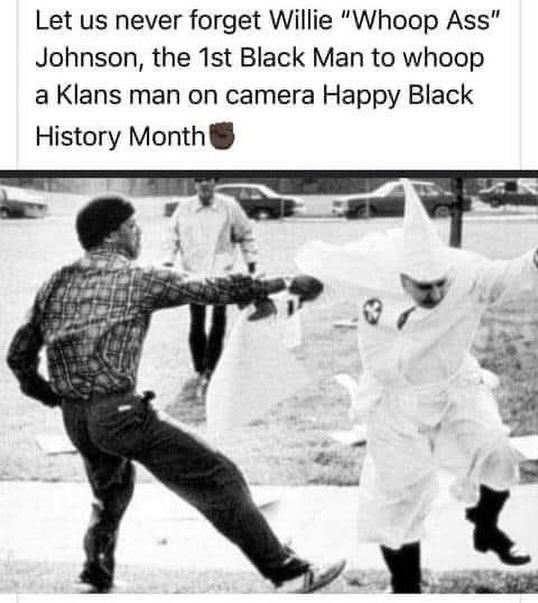
#black history#black history month#161#1312#antifa#antifascist#antifaschistische aktion#antinazi#antiauthoritarian#antiracism#how to be an antiracist#class war#goodnightwhitepride#anti imperialism#anti colonialism#ku klux klan#kkk#ausgov#politas#auspol#tasgov#taspol#australia#fuck neoliberals#neoliberal capitalism#anthony albanese#albanese government#nazisploitation#sacha baron cohen accuses tiktok of ‘biggest antisemitism movement since the nazis’#nazis
154 notes
·
View notes
Text
I want a 50 pack. Thank you.
79 notes
·
View notes
Text

JUDGE, February 13, 1926
#1920s#political cartoon#abraham lincoln#prohibition#ku klux klan#religious right#christian right#1926
63 notes
·
View notes
Text

Daryl Davis is a blues musician, but he also has what some might call an interesting hobby. For the past 30 years, Davis, a black man, has spent time befriending members of the Ku Klux Klan.
He says once the friendship blossoms, the Klansmen realize that their hate may be misguided. Since Davis started talking with these members, he says 200 Klansmen have given up their robes. When that happens, Davis collects the robes and keeps them in his home as a reminder of the dent he has made in racism by simply sitting down and having dinner with people.
•••
Daryl Davis es un músico de blues, pero también tiene lo que algunos podrían llamar un hobby interesante. Durante los últimos 30 años, Davis, un hombre negro, se ha hecho amigo de miembros del Ku Klux Klan.
Dice que una vez que florece la amistad, los miembros del Klan se dan cuenta de que su odio puede estar equivocado. Desde que Davis comenzó a hablar con estos miembros, dice que 200 miembros del Klan han renunciado a sus túnicas. Cuando eso sucede, Davis recoge las túnicas y las guarda en su casa como recordatorio de el hueco que ha hecho en el racismo simplemente por sentarse a cenar con la gente.
#blacklivesmatter#blacklivesalwaysmatter#english#spanish#blackhistory#history#share#read#blackhistorymonth#blackpeoplematter#knowledgeisfree#knowyourhistory#knowledgeispower#friendship#ku klux klan#black history 2023#black history matters#black history is everybody's history#black history is world history#historyfacts#black history is american history#black history month#black history#culture#follow#blackbloggers#blackhistoryyear#like#blackownedandoperated#blackowned
90 notes
·
View notes
Text
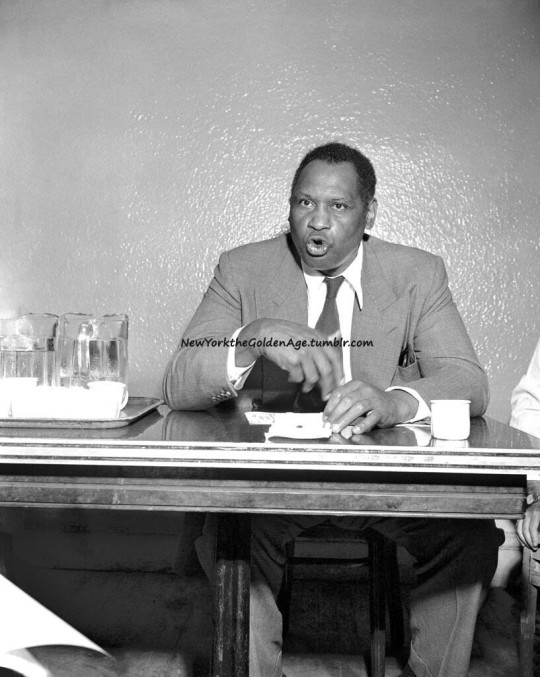
Paul Robeson speaks to reporters on August 28, 1949, about the riot in Peekskill where he was supposed to sing. The local KKK (yes, there was one) objected to his open admiration for Communism (as well as, no doubt, his color) and tore down the stage on which he was supposed to appear. Busloads of Harlem residents had gone to the concert, a benefit for the Harlem chapter of the Civil Rights Congress. Woody Guthrie, Pete Seeger, and Lee Hays were also on the bill. The ensuing riot injured eight people, two seriously.
Robeson asked Governor Thomas Dewey to open an investigation of the riot, but he refused.
Photo: Marty Lederhandler for the AP
#vintage New York#1940s#Marty Lederhandler#Paul Robeson#KKK#Ku Klux Klan#Aug. 28#August 28#28 August#28 Aug.#riot#anti-Communism#Peekskill riot
81 notes
·
View notes
Text
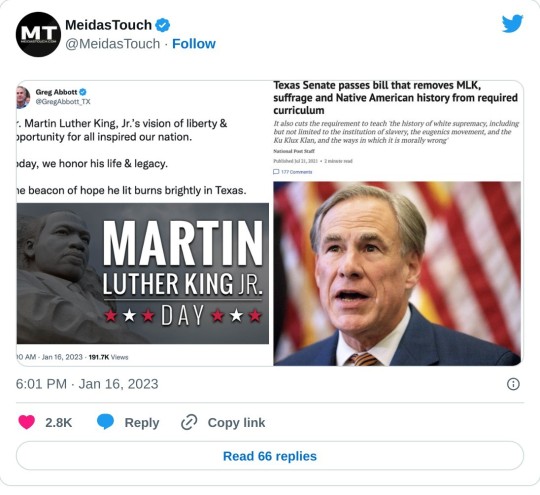
#us politics#2023#dr. martin luther king jr.#martin luther king jr#martin luther king day#texas#meidas touch#gov. greg abbott#women's suffrage#native americans#native american history#us history#education reform#critical race theory#white supremacy#american slavery#eugenics#ku klux klan#republicans be like#conservatives be like#fascists be like#gop#conservatives#republicans#racists
159 notes
·
View notes
Text

Thomas Hart Benton
Jesse James, from the Missouri State Capitol Mural Series, 1936 - Lithograph on Rives paper with GCM watermark, signed in pencil, from the edition of 100. - 16 1/4 x 21 7/8in
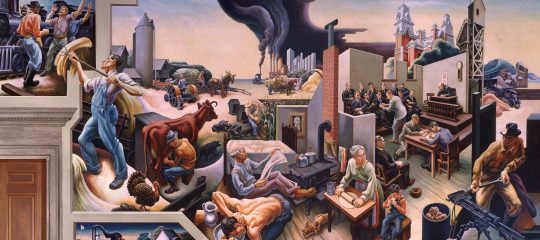
Thomas Hart Benton’s "A Social History of the State of Missouri". The mural, which is located in the House Lounge, has been open for public viewing since its completion in 1936.

Thomas Hart Benton with his painting Persephone via Kansas City Public Library

Thomas Hart Benton - Persephone
Thomas Hart Benton: 10 Facts About the American Painter
Thomas Hart Benton Was Born In A Small Missouri Town
Benton Attended The Art Institute Of Chicago And Académie Julien In Paris
He Was An Illustrator For The U.S. Navy During WWI - (Photograph Below)
He Was Jackson Pollock’s Teacher
He Was Head Of Kansas City Art Institute’s Painting Department
He Had Some Interesting Run-Ins With Magazines - (Explanation Below)
Benton’s Mural With Ku Klux Klan Members Still Sparks Controversy (Mural & Controversial Panel Below)
He Created A Mural For Missouri’s Capitol Building (Above the Fold)
Benton Was An Avid Harmonica Player
You Can Visit Thomas Hart Benson’s Home In Kansas City
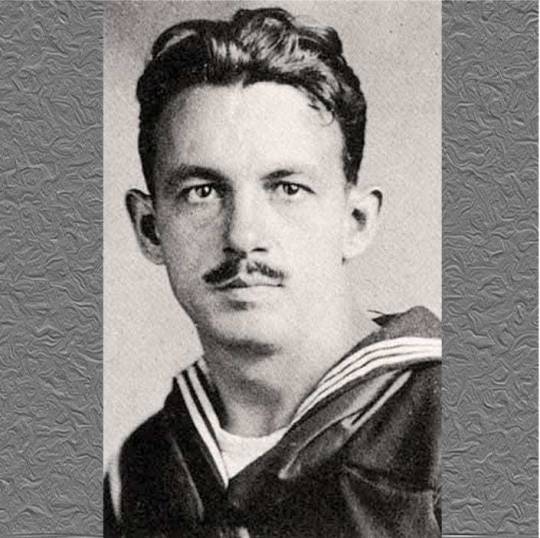
Thomas Hart Benton Service Photo

In 1934, Thomas Hart Benton was the first artist to ever appear on the cover of TIME Magazine.

Thomas Hart Benton - "Hollywood" - 1938
In 1937, Life Magazine commissioned a large painting from Benton on the subject of Hollywood, even paying for him to take a trip there over the summer of that year. His famous painting, Hollywood, was completed in 1938. When Life Magazine first saw the work, they immediately disapproved and wanted nothing to do with it, but the popularity of the work changed their tune and they included it in their spread about Hollywood.

A Social History of Indiana by Thomas Hart Benton, 1933, via The University of Indiana Bloomington
Thomas Hart Benton was commissioned to create a large mural for the state of Indiana in 1932 and it was presented at the 1933 Chicago World’s Fair. The mural, A Social History of Indiana, is made up of 22 large panels, spanning 250 ft in total, representing the state of Indiana.
The inclusion of the Ku Klux Klan brought heavy criticism when the mural was exhibited at the World’s Fair, but this didn’t stop the mural from being one of the most popular exhibits.
Cultural Panel 10 ("Parks, the Circus, the Klan, the Press") depicts a vivid, startling image of a Ku Klux Klan rally and a burning cross. The Klan had ruled Indiana politics during the 1920s—much to the embarrassment of progressives like Col. Lieber who preferred to bury the state's sins of the past.
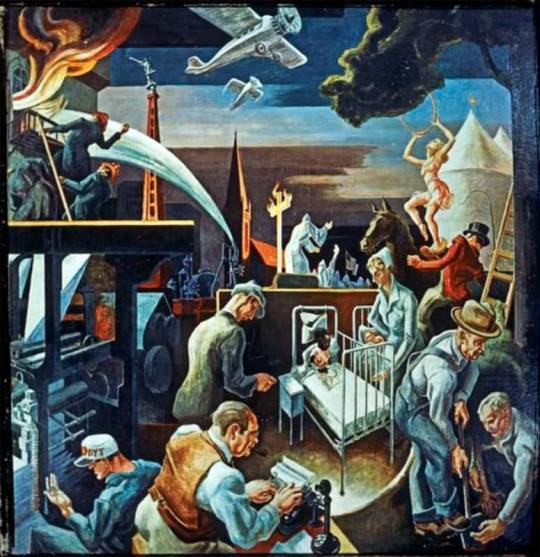
Cultural Panel #10 - The controversial panel, it is sad to see many of todays younger generation missing the point and simply looking to be offended by the past. (In 2017, students passed around a petition calling for its removal to which the university declared the lecture hall where it hangs will no longer be used for classes).

In Thomas Hart Benton’s Indiana mural, he attempts to point out the full history of Indiana, the good and the bad. Benton was not celebrating the Klu Klux Klan (KKK) in the mural, yet reminding the people of Indiana to recognize the past evils and how they were overcome.

Born: April 15, 1889 in Neosho, Missouri, son of Maecenus Eason Benton and Elizabeth Wise Benton
Died: January 19, 1975 in Kansas City, Missouri while finishing a large mural for the Country Music Hall of Fame in Nashville, Tennessee
#art#lithograph#Thomas Hart Benton#paintings#drawings#murals#artists#hollywood#time magazine#life magazine#social history#persephone#indiana#missouri#ku klux klan#jackson pollock#world's fair
40 notes
·
View notes
Text
By DANIELLE GREYMAN-KENNARD
Former United States Congresswoman Cynthia McKinney PhD shared an invitation on her X account this week, inviting her followers to a livestream titled “CAN BLACK PEOPLE AND WHITE PEOPLE WORK TOGETHER DEFEAT OUR COMMON ENEMY?” with a Star of David under the word “ENEMY.”
The Livestream, which was first brought to attention by activist X-user @GnasherJew, will feature former grand wizard of the Knights of the Ku Klux Klan and antisemite David Duke.
In other posts from the former Democrat, she shared an article claiming that “The Zionist regime was the prime force behind the 9/11 attacks, and that Israeli spies working for Mossad were celebrating the burning Twin Towers.”
Other instances of McKinney's antisemitism
This was not the first time that McKinney made such claims, as the Jerusalem Post reported in 2001. McKinney had shared a picture of the Twin Towers burning, with a hand slotting in a puzzle piece with "Zionists" written across it, to make up the full sentence "Zionists did it." She captioned the tweet "The Final Piece of the Puzzle."
43 notes
·
View notes
Text




11 notes
·
View notes
Text

“I see in the papers that the Department of Justice is to send out detectives etc and see if the mobs and other intimidations are being directed by the K.K.K.'s and I want to say a little about things in Arkansas.” Isaac McClellan to the DoJ, 2/10/1923.
Record Group 60: General Records of the Department of Justice
Series: Straight Numerical Files
File Unit: 198589 Section 5 [2/3]
Transcription:
ISAAC McCLELLAN
SHERIDAN
CIRCUIT COURT THIRD MONDAYS IN FEBRUARY AND AUGUST
CHANCERY COURT EACH MONTH
MCCLELLAN & MCCLELLAN
ATTORNEYS-AT-LAW
SHERIDAN, ARKANSAS
Feb. 10th, 1923
Department of Justice,
Washington, D.C.
My Dear Sir:-
I see in the papers that the Department of Justice is to send out detectives etc and see if the mobs and other intimidations are being directed by the K.K.K.'s and I want to say a little about things in Arkansas.
They are so thoroughly organized here, that the courts, and principal officials are members, and when they want a jury, they summons no one but their own, and if a K.K.K. is in any way involved in a suit, all of them are aiders and abettors, and an anti stands no chance at all in court against one of the members. It makes no difference what the evidence is or what the law is, the member wins. This sentiment is also to some extent getting into churches and in all walks of society, and in our public schools as to directors and teachers.
Several people here have received letters from them in a threatening manner, and it is not the low down or criminal class altogether, but some of the best citizens of our community who do not agree with the acts of this organization, have received letters. Some of them are now gone, as they felt like they had no protection. Many others are talking of selling out and leaving if they only knew where to go.
There is going to have to be something done as the State authorities cannot meet it, because when they go to a place to organize they try to get all the officials and preachers in to start the organization. If the Federal Government cannot meet the issue at once and successfully, the election matter is too big for partisanship, so all Americans should gladly unite now to fight the common enemy of our liberties. Shall the government endure or shall the Invisible Empire succeed it? Push your investigations at once and fast before it is too late.
Yours very truly,
Isaac McClellan
40 notes
·
View notes
Text

#goodnightwhitepride#ku klux klan#kluxbusters#kkkops#antinazi#antiracism#antiauthoritarian#class war#goodnightrightside#fucknazis#antinationalism#antinationalist#antizionist#anti capitalism#antifascist#antifaschistische aktion#ausgov#politas#auspol#tasgov#taspol#fuck neoliberals#australia#neoliberal capitalism#anthony albanese#albanese government#anarchism#anarchist#anarchocommunism#anarcho syndicalism
20 notes
·
View notes
Text
#talkin#tik tok#ebonywarriorstudios#ulysses s grant#the civil war#racism#reconstruction#kkk#ku klux klan#woodrow wilson#the birth of a nation
242 notes
·
View notes
Text
The Israeli government, settlers, and IDF soldiers are essentially the Ku Klux Klan given power, control, and free rein to slaughter by the western world.
That's all I see at this point. Their bigotry and barbarism is so disgusting and blatant that it reminds me of the klan. They even turn their violence and desecration towards Israeli leftists that defend Palestinians. So many parallels with the brutal savagery of the jim crow era.
Israel is afraid of no consequences however, at least the klan had to hide behind hoods and cloaks. Israel gets to indulge in bloodlust fueled by bigotry and gets say that all of that is just self-defense.
#israel#palestine#genocide#ku klux klan#self defense#settler colonialism#west bank#gaza#fuck netanyahu
7 notes
·
View notes
Text

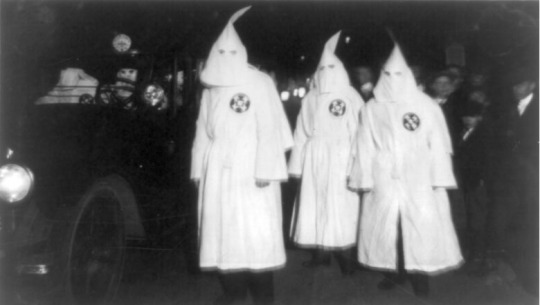
On June 10, 1966, Ben Chester White went about his morning routine. He headed off to work not knowing that the day would be his last day alive. White, a 67-year-old black plantation worker, was employed at Cooper Hill Plantation. It was the same plantation at which he worked his entire life, as well as the same at which his grandparents worked as slaves.
White was described as a hardworking, humble man that keep himself out of trouble. He was not an open active participant in the civil rights movement, nor was he registered to vote.
That fateful summer day, White was approached by Ernest Avants, James Lloyd Jones, and Claude Fuller; the three men offered White $2 and a soda in the exchange for his help to find their dog. White agreed to help the men, but as he was smart to the southern ways, he knew the white men were up to no good.
The men lured White into Pretty Creek in the Homochitto National Forest of Natchez, Mississippi. The plan was to murder White so that the publicity would draw Dr. Martin Luther King, Jr. to Natchez to be assassinated. However, White's death went unnoticed and unpunished; King never visited Natchez, nor did he publically discuss White's murder.
When White's body was found, it was riddled with bullet holes.
Police connected his death with an abandoned, shot up, and burned car that was discovered, which belonged to James Lloyd Jones.
Jones confessed to the murder, telling the police that when they shot White, his brains "went all over the place." Jones explained that "Fuller shot White with a machine gun," and Avants "blew his head off."
Avants was already suspected of having ties with the Klan; he refused to talk about his Klan affiliation. Rumors had it that the three men were members of the Cottonmouth Moccasin Gang, a faction of the White Knights of the Ku Klux Klan.
The three murderers went to trial separately. Jones was tried first. He confessed his role and expressed repentance; the jury was deadlocked. Avants was acquitted; his defense was Fuller had already killed White, so Avants' additional shots had no effect. Fuller claimed health problems and was able to avoid trial.
In 1968, Jesse White, Ben Chester's son, sued the KKK for his father's death.
The judge ruled in his favor and awarded $1 million. While this ruling set a precedent, being the first time that the Klan, is held responsible, Jesse and his family never received compensation.
•••
El 10 de junio del año 1966, Ben Chester White siguió con su rutina matutina. Se dirigió al trabajo sin saber que ese sería su último día con vida. White, de 67 años, era un trabajador de plantación, trabajaba en Cooper Hill Plantation. Era la misma plantación en la que trabajó toda su vida, también era la misma en la que sus abuelos habían trabajado como esclavos.
White fue descrito como un hombre humilde y trabajador que se mantenía alejado de los problemas. No fue un participante activo abierto durante el movimiento de los derechos civiles, tampoco estaba registrado para votar.
Ese fatídico día de verano, Ernest Avants, James Lloyd Jones y Claude Fuller se acercaron a White; los tres hombres le ofrecieron a White $2 y un refresco a cambio de su ayuda para encontrar a su perro. White accedió a ayudar a los hombres, pero como sabía sobre las costumbres sureñas, sabía que los hombres blancos no tramaban nada bueno.
Los hombres llevaron a White a Pretty Creek en el Bosque Nacional Homochitto de Natchez, Mississippi. El plan era asesinar a White para que la publicidad atrajera al Dr. Martin Luther King, Jr. a Natchez para ser asesinado. Sin embargo, la muerte de White pasó desapercibida e impune; King nunca visitó Natchez, ni discutió públicamente el asesinato de White.
Cuando se encontró el cuerpo de White, estaba lleno de agujeros de bala.
La policía conectó su muerte con un automóvil abandonado, baleado y quemado, que pertenecía a James Lloyd Jones.
Jones confesó el asesinato y le dijo a la policía que cuando le dispararon a White, su cerebro "se descontroló". Jones explicó que "Fuller le disparó a White con una ametralladora" y Avants "le voló la cabeza".
Avants ya era sospechoso de tener vínculos con el Klan; se negaba a hablar sobre su afiliación al Klan. Los rumores decían que los tres hombres eran miembros de Cottonmouth Moccasin Gang, una facción de los Caballeros Blancos del Ku Klux Klan.
Los tres asesinos fueron a juicio por separado. Jones fue juzgado primero. Confesó su papel y expresó arrepentimiento; el jurado estaba estancado. Avants fue absuelto; su defensa era que Fuller ya había matado a White, por lo que los disparos adicionales de Avants no surtieron efecto. Fuller alegó problemas de salud y pudo evitar el juicio.
En 1968, Jesse White, el hijo de Ben Chester, demandó al Ku Klux Klan por la muerte de su padre.
El juez falló a su favor y otorgó $ 1 millón. Aunque este fallo sentó un precedente, siendo la primera vez que se responsabilizaba al Klan, Jesse y su familia nunca recibieron compensación.
#blacklivesmatter#blacklivesalwaysmatter#english#spanish#blackhistory#history#share#read#blackhistorymonth#blackpeoplematter#ku klux klan#knowyourhistory#historyfacts#blackbloggers#black history is american history#blackhistoryyear#black history month#black history#black tumblr#blackownedandoperated#blackowned#blackhistoryeveryday#blackhistoryfacts#blackhistory365#black history is world history#black history is everybody's history#black history matters#black history 2023#follow#blm
24 notes
·
View notes
Text

In modern times, cross burning or cross lighting is a practice which is associated with the Ku Klux Klan. However, it was practiced long before the Klan's inception. Since the early 20th century, the Klan burned crosses on hillsides as a way to intimidate and threaten African Americans and other marginalized groups.

In the first era, reconstruction Klans did not burn crosses. The belief that reconstruction Klans burned crosses was introduced by Thomas Dixon Jr., in his novel The Clansman: A Historical Romance of the Ku Klux Klan (1905). A cross burning is first described in Book IV Chapter 2 "The Fiery Cross" on pages 324–326 of the 1905 edition. It is introduced by one of the characters as "the old Scottish rite of the burning cross. It will send a thrill of inspiration to every clansmen in the hills." It is further elaborated that
In olden times when the Chieftain of our people summoned the clan on an errand of life and death, the Fiery Cross, extinguished in sacrificial blood, was sent by swift courier from village to village. This call was never made in vain, nor will it be to-night in the new world. Here, on this spot made holy ground by the blood of those we hold dearer than life, I raise the ancient symbol of an unconquered race of men—
This scene is accompanied by an unnumbered plate illustration by Arthur I. Keller, captioned "'The fiery cross of old Scotland's hills'", showing two robed, unmasked Klansmen, one of whom is holding a lighted cross, over a bound, blindfolded and gagged African American, while robed and hooded klansmen look on. The novel ends with a Klansman waiting for election results stating "Look at our lights on the mountains! They are ablaze - range on range our signals gleam until the Fiery Cross is lost among the stars" meaning that he had won and civilization had been saved in the South. The fiery cross is mentioned once again in the final novel of Dixon's Klan trilogy, The Traitor: A Story of the Fall of the Invisible Empire, when a Grand Dragon tosses a burning cross on a heap of discarded Klan robes and regalia in obedience to the order of the Grand Dragon to dissolve the order. This scene is accompanied by an illustration captioned "Some of the men were sobbing" by Charles David Williams featuring a gathering of Klansmen over a burning pile of robes, carrying three burning crosses.

Origins of Burning Crosses goes back to Scottish origins
Scottish origins
A Victorian depiction of the crann tara
In Scotland, the fiery cross, known as the crann-tara, was used as a declaration of war. The sight of it commanded all clan members to rally to the defence of the area. On other occasions, a small burning cross would be carried from town to town. It was used in the War of 1812 between Britain and the U.S. as a means of mobilizing the Scottish Fencibles and militia which were settled in Glengarry County, Ontario against the invaders. In 1820, over 800 fighting men of Clan Grant were gathered, by the passing of the fiery cross, to come to the aid of their Clan Chieftain and his sister in the town of Elgin, Scotland. In Scotland itself, the last significant use of the burning cross was made in 1745, during the Jacobite rising, and it was subsequently described in the novels and poetry of Sir Walter Scott, particularly The Lady of the Lake of 1810
#kemetic dreams#afrakan#scotland#scotsman#scottish#britain#glasgow#wales#edinburgh#burning crosses#european#grand dragon#kkk#ku klux klan#european culture#burning#white supremism
4 notes
·
View notes